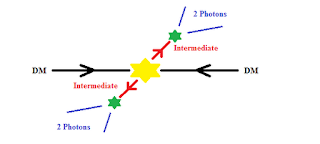To go into more detail, we'll need to cover some basic kinematics.
We don't know much about dark matter, but one thing that we do know is that it is non-relativistic. We know this from simulations of galaxy formation; fast-moving dark matter impedes the gravitational collapse that creates galaxies (and clusters, stars, and so on). This means that the total energy in a dark matter collision is almost all the mass energy, with no kinetic energy:
$E = m c^2 \gg m v^2$
When considering dark matter annihilation, we can treat the dark matter as being at rest.Now, let us first consider the usual approach: two dark matter particles annihilating to two photons.
We can figure out what the produced photons look like using conservation of energy and momentum. The initial momentum is practically zero because the dark matter is effectively at rest. So the final state photons must have equal and opposite momentum. (For particles with mass, this would mean they have the same speed and are travelling back-to-back, but for light it's slightly more complex.) Photons with the same magnitude of momentum have the same energy, and therefore the photons have
$E = m c^2$
This gives us the line spectrum, that is broadened to a bump by detector resolution.Now, the momentum part of the argument is independent of their nature of the final particles. So if the dark matter annihilates to two of any other particle, they also have the equal and opposite momentum. Identical particles with the same magnitude momentum then have the same energy, in this case the dark matter mass energy. Now assume that these second particles go on to decay to two photons.
Repeating the argument shows that in the rest frame of the decaying particle, the photons have equal energy, half the mass energy. But from our point of view, the decaying particles will be moving; so the photons will be red- or blue-shifted by the relativistic Doppler effect. That is; the photon travelling in roughly the same direction as the intermediary particle will have more energy, and the other one will have less.
Interestingly, if you work out the probability for the photon to be emitted at a particular angle relative to the intermediate state, and account for the boost associated with that, you end up with a box spectrum. That is, there is a lower limit on the energy (for when the photon is going in exactly the opposite direction) and an upper limit (exactly the same direction), but all energies between those two points are equally likely. The upper and lower limits depend only on the mass of the initial dark matter, and the unstable secondary.
Now, a box shape looks somewhat similar to a line in practice, as the sharp edges get smoothed by the finite accuracy of the equipment. Still, it is possible to distinguish the two bumps based on their width in most cases. The exception is when the particle that decays to photons is only slightly less massive than the dark matter. In particular, if the two particles are nearly degenerate,
$K.E. = (m_\chi - m_\pi) c^2 \ll m_\chi c^2$
That is, the kinetic energy of the intermediate states is much less than their mass energy. This is precisely the case we already considered for the dark matter! So much like them, we can treat the photons as being produced in the decay of stationary particles, and will have a line spectrum.There are a few consequences of this. The first is that the overall process is now two dark matter particles produce four photons with equal energy. The photons then have energy equal to half the dark matter mass energy, so our dark matter is twice as heavy. Also, because the dark matter does not directly couple to electrically charged particles, all the problems from indirect constraints and so on do not apply.
However, the problem with this idea is that you now have to explain why you have these two particles, one stable (dark matter) and one decaying to photons. It looks a bit unnatural at first. The second point of Reese and Fan was that not only is this easy to arrange, there's something very much like it we've already found! Degenerate particles are a typical sign of a symmetry. Indeed, something very much like this already exists in nature with the pions. The pions are the three lightest hadrons, and like all hadrons are composite states of quarks. Two of them are charged (and are each other's antiparticle), and the third is neutral. They have nearly the same mass, thanks to an accidental symmetry of the strong interaction.
In reality, all the pions are unstable with lifetimes much less than a second. The dominant decay of the neutral pion is indeed to two photons! Additionally, if the electron did not exist then the charged pions would be stable by conservation of electric charge. This would let the charged pions be "light matter" (since they interact with light); and the annihilation of positive and negatively charged pions to two neutral pions, and thereby four photons, would be very important.



No comments:
Post a Comment